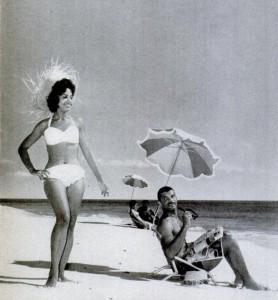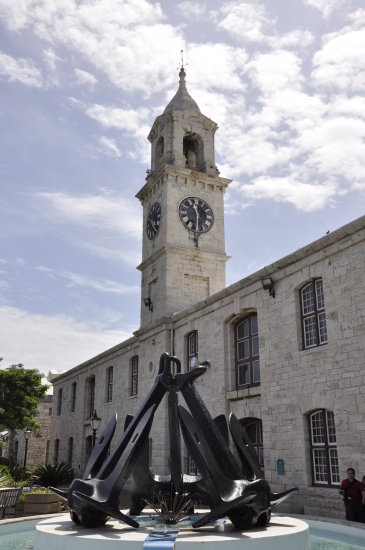‘Not-So-Beautiful Bermuda …’
 Yellow fever victims being buried alive. A leper colony. And the fact Royal Navy apprenticeships provided blacks with a means of escape from educational and economic segregation were some of the topics raised by a transplanted Bermudian attempting to introduce African-Americans to realities of Bermuda life not touched on in post-World War Two travel articles.
Yellow fever victims being buried alive. A leper colony. And the fact Royal Navy apprenticeships provided blacks with a means of escape from educational and economic segregation were some of the topics raised by a transplanted Bermudian attempting to introduce African-Americans to realities of Bermuda life not touched on in post-World War Two travel articles.
Writing in Baltimore’s “Afro-American” in 1947, S. Otis Swan — who had migrated to the US decades earlier — said the glowing portrayal of Bermuda in a report published by that newspaper was not so much inaccurate as incomplete.
Before segregation ended here in 1959, the island’s Trade Development Board [TDB] — forerunner to the modern Tourism Ministry — routinely brought journalists from African-American newspapers and magazines to the island to write promotional pieces about black-owned guest houses and hotels [a vintage TDB ad aimed at black American visitors is reproduced here].
Mr. Swan said, “Some grim phases of not-so-beautiful Bermuda are obviously intentionally avoided by those who show visitors over the island.”
His full article — entitled “A Native Bermudian Gives Another Side To Beautiful Bermuda” — appears below:
The interesting article ”Beautiful Bermuda” overlooks, as do all articles I have ever read about my home, an important factor in the economic life of colored Bermudians.
I refer to the hundreds of skilled craftsmen who are employed in His Majesty’s Dockyard.
The floating dock at Ireland Island was at one time the largest in the world. Now, though in second or perhaps third place, it is able to dock the largest battleships of the British Navy.
Its personnel is largely colored and includes electricians, plumbers, carpenters, riggers, blacksmiths and practically every handicraftsman imaginable. The men attain journeyman status after a rigid five-year apprenticeship.
Applicants between the ages of 14 and 18 become eligible after being successful in an annual competitive examination, the candidates with the highest passing grade having first selection of the apprenticeships open and so on down the line.
By applying to a transfer to England, a colored journeyman can become “Anglicized” to the extent that he can eventually be sent out to the colonies as an English master mechanic.
I don’t pretend to understand the philosophy of this but I know of instances where a native has returned, after a few years in England, with the status and pay of an English master mechanic or supervisor regardless of the color of his skin.
Some grim phases of not-so-beautiful Bermuda are obviously intentionally avoided by those who show visitors over the island.
No visitor seems to have learned Bermuda has a leper colony with a history both tragic and dramatic.
For sheer drama, few stories could surpass that of the young girl who was committed to this “sanatorium” at the age of 16; was kept incommunicado for 10 years, finally released as cured, and is today a happy wife and mother.
No one probably cares to tell the visitor of the yellow fever horror in the middle of the 19th century. Then it was the peculiar custom to bury the dead on the same day if death occurred in the morning or the next morning if death occurred at night [embalming was unknown].
Then followed the fashion of interring in sealed vaults where the caskets were placed on one another so that one vault was sufficient for one family — the coffin at the bottom collapsing and making way for new ones. This was a horror that was remembered up to 40 years ago.
The yellow fever scourge killed the inhabitants so rapidly that formal burial rites were temporarily abandoned.
When graves were opened some time later it was found that some of the yellow fever victims had been buried alive.
The crisis of yellow fever left some in a coma that to the casual eye resembled death.
Sextons found some coffins forcibly broken open from the inside and the occupants in horrible crouching or standing positions.
Yes, “Beautiful” Bermuda has some phases in its history that might spoil its beauty for the casual visitor but which are ‘copy’ just the same.



WAT IS THE POINT
just because it glitter it was once a rough diamond!
As a Bermudian, I did not even know of the yellow fever outbreak and leper colony.
Wasn’t the leper colony and the quaruntine for yellow fever both based out on Nonsuch? It was interesting to learn more about the past, and I wish this kind of thing was incorporated into my schooling. I know all about the Kings and Queens of England, but not much about our own history.
Not sure if there was one out there, but there was one on what is now Devon Springs Lane, off South Road in Devonshire. If you head up to the top of the road, about 100 yards away from MAWI, on the right hand side of the road you’ll see some cottages that used to be part of such a colony. On the immediate left hand side of the road, on the property now occupied by Devon Spring Apartments, you’ll see a rather odd single-storey building that appears split in half with a breezeway through the middle: this was the old lepers chapel. It was believed that the breezeway would prevent the Minister from being able to contract any disease from the lepers, who would stay on the other side of the breezeway.
There was also a Board of Health hospital located on Cedar Hill in St George’s for victims of the epidemic.
????????
Reads like an article borne out of anger and resentment. TBD knew their markets and targeted them accordingly. Perhaps that would account for Bermuda’s success in the 40′s, 50′s, 60′s and 70′s with tourism. It beggars belief that someone would think that a tourist, looking to ‘get away from it all’, would be lured to a destination portrayed as a former a yellow fever infested leper colony!… And to top things off, a place where locals are offered opportunities of apprenticeship and travel (oh the horror of this one alone *sarcasm*).
The article is very interesting in terms of the history of the island, without doubt. However, as a vehicle for attracting tourists, it is wholly inappropriate.
Mr. Swan wrote about this in 1947 after living away from Bermuda “for decades”. He was referring to the mid-1800s when yellow fever swept through Bermuda many times, killing mostly British military I believe, but maybe local black skilled craftsmen who worked at Dockyard were exposed to yellow fever too. I didn’t know about leprosy in Bermuda but like all locations, I’m sure that Bermuda was not immune to the diseases of that period of history. It is always good to learn about Bermuda’s history, but Mr. Swan’s writing sounds angry that tourists weren’t told that a few people were buried alive in Bermuda. Did he really think marketing material for Bermuda should include that???? What does this all have to do with 2011? I must be missing something…
The man enjoying the sun in the first photo appears to be none other than The Honourable Quinton Edness. That would be around the time Quinton had his own radio show on ZBM I think it was called The Musical Ballroom.
It is indeed the Hon. Quinton Edness; and the lovely young lady is Sally Lewis and American who danced with Don Gibson’s Holiday Island Review.